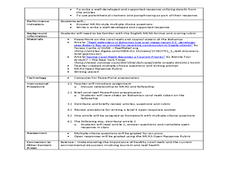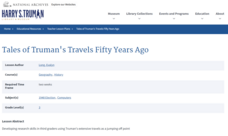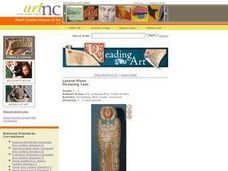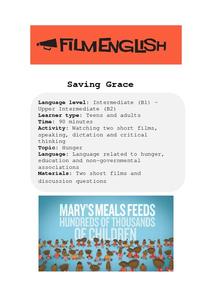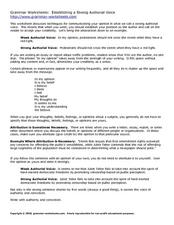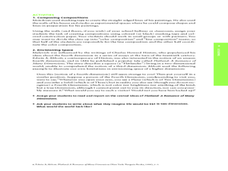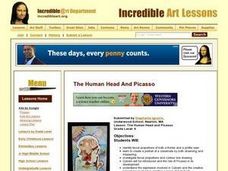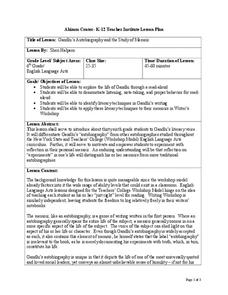Curated OER
Bahamian Coral Reef Development
Students study tourism and conservation. For this coral development lesson students view a PowerPoint presentation and write a report.
Curated OER
Poetry for Kids
Sixth graders be immersed indirect experiences which are opportunities for students to reflect, look back, debrief or abstract from their experiences what they have felt, and thought, and studied.
Curated OER
Comparison/Contrast Composer Study
Pupils choose two composers to research and complete a compare and contrast study of them. In this composer research lesson plan, learners select two composers to research. Pupils use Internet sources, the library, and music class...
Curated OER
Tales of Truman's Travels Fifty Years Ago
Fourth graders study President Truman and the Whistlestop Campaign. For this US history lesson, 4th graders complete a KWL about President Truman and write letters to stops on Truman's Whistlestop Campaign. Students create a presentation...
Curated OER
Early American Leaders
Students discover what the qualities or characteristics of a leader are by describing the traits of the principal of the school, followed by the leader of the town, state and country. In this leadership lesson plan, students will take...
Curated OER
Chocolate Graphing
Chocolate lovers develop a bar graph based on the types of chocolate the class likes. They participate in The Art of Chocolate at The Hershey Story before they make a bar graph that shows the favorite chocolate types of their class. They...
Curated OER
Using Non-Text Features
Second graders examine graphs and charts from their local newspaper. As a class, they discuss what the data means and how it relates to the article. In groups, they are shown two sets of graphs or charts and they practice explaining...
Curated OER
Become a Character: Adjectives, Character Traits, and Perspective
Students use an online chart to match the character traits of a character in a book they are reading with specific actions the character takes. Students then work in pairs to "become" one of the major characters in a book and describe...
Curated OER
Picturing Text
Learners, through observation and discussion about the Coffin of Djed Mut, make connections between hieroglyphs and the English writing system. They create their own visual story using symbols that represent words.
Core Knowledge Foundation
A “Whole” Lot of Fraction Fun!
Young mathematicians are introduced to fractions in a unit that helps them to understand parts of a whole.
Project Maths
Introduction to Trigonometry
The topic of trigonometric ratios is often covered with loads of rote memorization baked into the activity. This activity set, however, leans more on using similar triangles and discovery learning to help young geometers develop a deeper...
Core Knowledge Foundation
Genetics and the Master Race
How did the beginnings of genetic research influence the Nazi party? A thorough, engaging unit incorporates the work of Gregor Mendel, the study of inherited traits, and the use of racism and discrimination during the Holocaust.
Film English
Saving Grace
Bring up the topic of world hunger in your class with two emotional videos. The short films are about a program for educating and feeding children around the world. Class members talk about poverty and pay close attention to the...
Curriculum Corner
“I Can” Common Core! 3rd Grade Language
Support third graders with developing their language skills using this Common Core checklist. With each standard written as an I can statement, children are given clear learning goals to work toward throughout the year.
Curated OER
Establishing a Strong Authorial Voice
Why do some phrases contribute to a weak authorial voice? The first page of this packet explains what a strong and weak voice sound like, and it lists some common phrases that clutter writing, ultimately weakening it. The second page...
Curated OER
New Visions of the World
Students explore the art of Kazimir Malevich and Piet Mondrian as an analysis of abstract painting. In this abstract painting lesson, students explore the painting style of the two artists. Students analyze the use of shape, line,...
Curated OER
The Human Head and Picasso
Sixth graders view human head paintings by Picasso. Using the paintings, they identify the facial proportions by a frontal and profile view. With a partner, they create a portrait of them after observing and measuring their face. They...
Curated OER
The Changing Experience of Colonial Childhood
High schoolers research how childhood was depicted in art in the 17th through 19th centuries. In groups, they research pieces of art and write a paper explaining how the portrayal of students in art changed at the end of the 18th century.
California Academy of Science
Energy: A Day in My Life
If only we could harness the energy of fifth graders, our energy problems would be over! The class discusses where different forms of energy come from and how we use them. They complete a chart of the activities that they do daily...
Curated OER
Do You See What I See?
Students listen to oral directions to reproduce a work of art. They apply their listening skills, demonstrate their ability to follow directions, and show their knowledge of directional terms to reproduce an abstract piece of art.
Curated OER
Theatre of the Absurd
Learners are introduced to the Absurd Theatre movement. They practice using the same techniques as performers in the theater. At the end of the lesson, they perform for their classmates.
Curated OER
Core Poetry and More
Second graders examine poetry in the context of American History in the four lessons of this unit. They read, write, and edit their own pieces in this unit.
Curated OER
Gandhi's Autobiography and the Study of Memoir
Seventh graders explore the life of Gandhi using his autobiography and memoir. In this Gandhi exploration instructional activity, 7th graders analyze Gandhi's literary voice by reading his autobiography. Students identify literary...
Curated OER
My Ideal World
Students create an image symbolic of their ideal world. In this lesson inspired by To Kill a Mockingbird and the artwork of Edward Hicks, students use Adobe Photoshop to create an image symbolic of their personal utopia.
